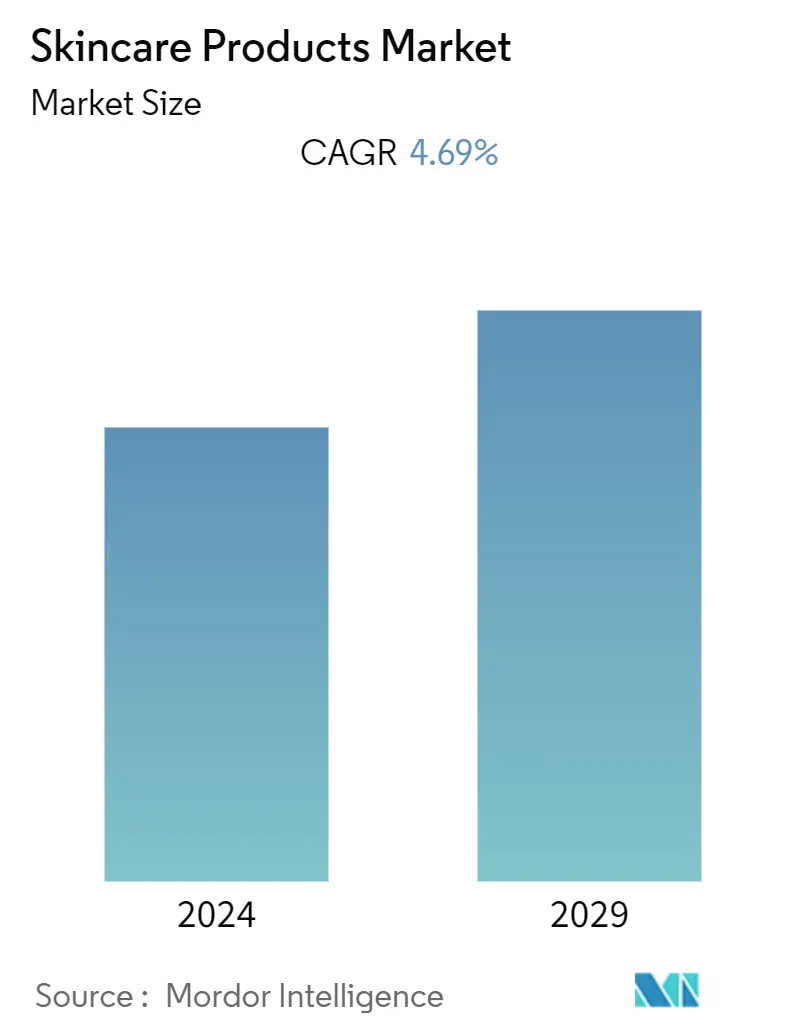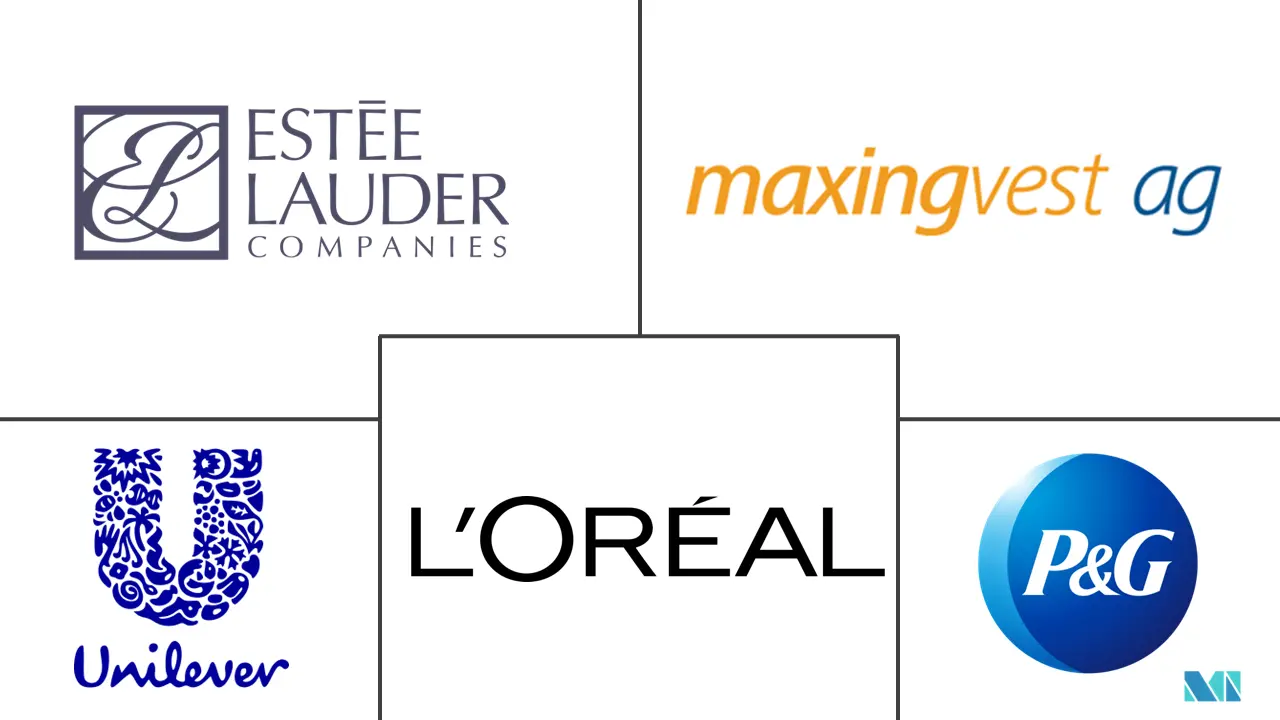Market Size of Skincare Products Industry

| Study Period | 2019 - 2029 |
| Base Year For Estimation | 2023 |
| CAGR (2024 - 2029) | 4.69 % |
| Fastest Growing Market | North America |
| Largest Market | Asia Pacific |
| Market Concentration | Low |
Major Players
*Disclaimer: Major Players sorted in no particular order |
Skin Care Products Market Analysis
The Skincare Products Market is expected to register a CAGR of 4.69% during the forecast period.
- Urban areas have seen an increase in customers' propensity toward various skincare products because of expanding disposable income, intense advertising activities, and the debut of innovative products by manufacturers. For instance, in September 2021, Kao Corporation launched a new Sheet Mask called Smile Performer. The sheet mask claims to add radiance and bounce to the skin, which creates a smiling impression.
- Consumers are using skincare products earlier as they become more aware of skin issues and treatments, which is helping the market grow. An increasing number of women are opting for anti-aging products like L'Oreal Revitalift, Avon Anew Sensitive+, Caudalie premier cru anti-aging cream moisturizer with hyaluronic acid, and many more, which make up a significant sector of the skincare products industry.
- With the growing demand for organic ingredients, consumers across the market are inclined toward organic skin care products, which is expected to drive market growth during the study period. Furthermore, the rising awareness about the harmful effects of chemicals and synthetic products is another factor augmenting the development of the market. Most consumers tend to buy products with natural or organic labeling, which drives market growth.
- People face significant skin rashes and sensitivity in many regions due to environmental conditions like UV rays, deserts, and pollution. This is why they prefer products with hydrating properties like vitamin C serums, hyaluronic acid creams, and face masks, which also drive the market. For instance, in June 2022, Biologi, an Australian clean cosmeceutical business, unveiled an anti-pollution serum with a wild-harvested extract containing vitamin C, niacinamide, and salicylic acid.
- The Bg defence anti-pollution serum is the newest addition to Biologi's distinctive serum line, and it features strawberry gum leaf extract as its main ingredient. The serum is designed to shield and protect skin against environmental assaults like blue light and pollution on a daily basis.
Skin Care Products Industry Segmentation
Skincare products are a range of products that support skin integrity, enhance appearance, and relieve skin conditions. These are applied to the skin to avoid symptoms of early aging, pimples, and black patches.
The skincare products market is segmented by product type, category, distribution channel, and geography. Based on product type, the market is segmented into facial care: cleansers, moisturizers, creams and lotions, serums and essence, toners, face masks and packs, and other facial care products; lip care; body care: body wash and body lotions. Based on category, the market is segmented into premium skincare products and mass skincare products. Based on the distribution channel, the market is segmented into specialist retail stores, supermarkets/hypermarkets, convenience stores, pharmacies/drug stores, online retail stores, and other distribution channels. Based on geography, the market is segmented into North America, Europe, Asia-Pacific, South America, and Middle East & Africa.
For each segment, the market sizing and forecasts have been done based on value (in USD billion).
| Product Type | ||||||||
| ||||||||
| Lip Care | ||||||||
|
| Category | |
| Premium Skincare Products | |
| Mass Skincare Products |
| Distribution Channel | |
| Specialist Retail Stores | |
| Supermarkets/Hypermarkets | |
| Convenience Stores | |
| Pharmacies/Drug Stores | |
| Online Retail Channels | |
| Other Distribution Channels |
| Geography | |||||||||
| |||||||||
| |||||||||
| |||||||||
| |||||||||
|
Skincare Products Market Size Summary
The skincare products market is experiencing significant growth, driven by increasing consumer awareness and demand for innovative and effective solutions. Urbanization and rising disposable incomes have led to a heightened interest in skincare, with consumers increasingly seeking products that address skin issues and enhance appearance. The market is witnessing a shift towards organic and natural ingredients, as consumers become more conscious of the harmful effects of chemicals and synthetic products. This trend is further supported by the growing popularity of anti-aging products, which are in high demand due to increasing awareness of pollution's impact on skin health. Companies are responding to these trends by launching new products and forming strategic partnerships to strengthen their market position.
In regions like Asia, the skincare market is expanding rapidly due to factors such as population growth, urbanization, and increased spending on personal care. The availability of affordable skincare products is also contributing to market growth, with key players focusing on product innovation and strategic mergers and acquisitions. The competitive landscape is marked by the presence of major global and regional players, who are actively seeking to expand their market share through various strategies, including product development and local market expansion. The market's growth is further fueled by the increasing number of beauty salons and the rising demand for organic skincare solutions, particularly in response to environmental and chemical-related skin issues.
Skincare Products Market Size - Table of Contents
-
1. MARKET DYNAMICS
-
1.1 Market Drivers
-
1.2 Market Restraints
-
1.3 Porter's Five Forces Analysis
-
1.3.1 Threat of New Entrants
-
1.3.2 Bargaining Power of Buyers/Consumers
-
1.3.3 Bargaining Power of Suppliers
-
1.3.4 Threat of Substitute Products
-
1.3.5 Intensity of Competitive Rivalry
-
-
-
2. MARKET SEGMENTATION
-
2.1 Product Type
-
2.1.1 Facial Care
-
2.1.1.1 Cleansers
-
2.1.1.2 Moisturizers, Creams, and Lotions
-
2.1.1.3 Serums and Essence
-
2.1.1.4 Toners
-
2.1.1.5 Face Masks and Packs
-
2.1.1.6 Other Facial Care Products
-
-
2.1.2 Lip Care
-
2.1.3 Body Care
-
2.1.3.1 Body Wash
-
2.1.3.2 Body Lotions
-
-
-
2.2 Category
-
2.2.1 Premium Skincare Products
-
2.2.2 Mass Skincare Products
-
-
2.3 Distribution Channel
-
2.3.1 Specialist Retail Stores
-
2.3.2 Supermarkets/Hypermarkets
-
2.3.3 Convenience Stores
-
2.3.4 Pharmacies/Drug Stores
-
2.3.5 Online Retail Channels
-
2.3.6 Other Distribution Channels
-
-
2.4 Geography
-
2.4.1 North America
-
2.4.1.1 United States
-
2.4.1.2 Canada
-
2.4.1.3 Mexico
-
2.4.1.4 Rest of North America
-
-
2.4.2 Europe
-
2.4.2.1 United Kingdom
-
2.4.2.2 Germany
-
2.4.2.3 Spain
-
2.4.2.4 France
-
2.4.2.5 Italy
-
2.4.2.6 Russia
-
2.4.2.7 Rest of Europe
-
-
2.4.3 Asia-Pacific
-
2.4.3.1 China
-
2.4.3.2 Japan
-
2.4.3.3 India
-
2.4.3.4 Australia
-
2.4.3.5 Rest of Asia-Pacific
-
-
2.4.4 South America
-
2.4.4.1 Brazil
-
2.4.4.2 Argentina
-
2.4.4.3 Rest of South America
-
-
2.4.5 Middle East & Africa
-
2.4.5.1 South Africa
-
2.4.5.2 Saudi Arabia
-
2.4.5.3 Rest of Middle East & Africa
-
-
-
Skincare Products Market Size FAQs
What is the current Skincare Products Market size?
The Skincare Products Market is projected to register a CAGR of 4.69% during the forecast period (2024-2029)
Who are the key players in Skincare Products Market?
L'Oréal S.A., Unilever PLC, Procter & Gamble Company, maxingvest AG (Beiersdorf AG) and The Estée Lauder Companies Inc. are the major companies operating in the Skincare Products Market.

